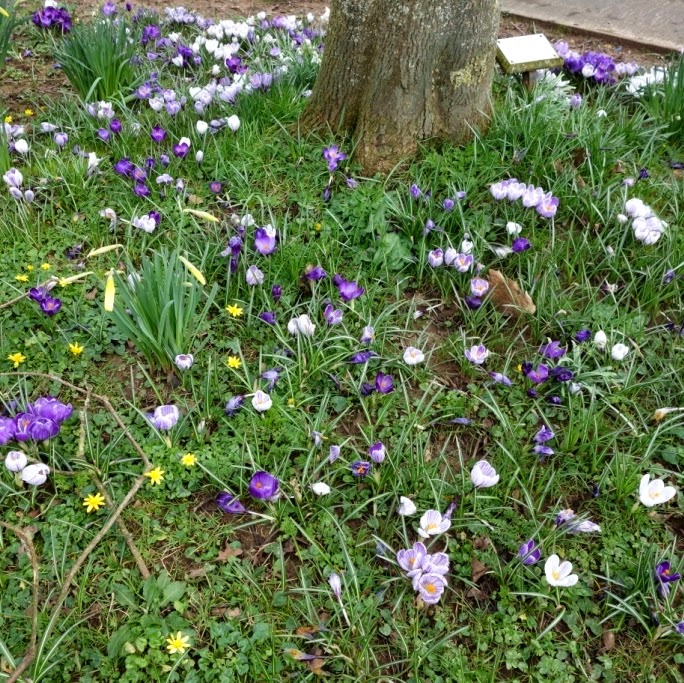Trees and flowers
With the arrival of
Spring, and for this first post, we focus on Village Road, beginning at the
corner with Bond’s Lane. The open land here was
once Bond’s Farm, which burned down in 1860 and was never rebuilt. Fragments of old wall can still be seen on
the side of the hedge facing the road. This area now belongs to the Parish Council, and a
variety of trees were planted here about five years ago.
One of these is a very beautiful, early flowering Prunus Kursar (a variety of Japanese cherry), which is putting on a wonderful display of deep pink flowers. Nearby a wild Prunus has tiny wild flowers which contrast dramatically with its darker bark. On a sunny morning. both trees were absolutely humming with worker bees.
One of these is a very beautiful, early flowering Prunus Kursar (a variety of Japanese cherry), which is putting on a wonderful display of deep pink flowers. Nearby a wild Prunus has tiny wild flowers which contrast dramatically with its darker bark. On a sunny morning. both trees were absolutely humming with worker bees.
 |
| Prunus Kursar, below with wild Prunus behind |
 |
| Flowers of Prunus Kursar (above) and wild Prunus (below) |
Elsewhere along Village Road (as in all our lanes) hazel catkins have been visible for several weeks in hedges, and overhanging the brook along the Plantation in the centre of the village - although many are now going over (the darker coloured ones). The long pendulous catkins are male flower heads and are a crucial food for early foraging bees. The female flowers are much harder to see: little lumps like leaf buds on the branch, with crimson tentacles.
At the time of writing, the
last of the snowdrops are still open.
Sometimes known as ‘fair maids of February’, they were introduced into
England by the Romans and have become wild in the West Country.
 |
| Snowdrops |
The flowers of the moment are now the distinctive yellow Lesser Celandine – in profusion in the Plantation and along the roadsides – and primroses.
Sarah Raven (in her book Wild Flowers) describes the lesser celandine as the ‘buttercup of spring’. “Its leaves are elegant, like a shiny, bright green version of a cyclamen leaf.... Because it is everywhere, in great numbers, it may be under-appreciated. This is a shame because it is friendly, sunny and simple, with pure-yellow insides to its flowers, washed green or bronze on the outer surface. Lesser celandine is an invaluable early season source of pollen and nectar for many insects.” Unpopular with gardeners because of its ability to spread quickly, carpets of it are nevertheless a spectacular sight at the end of winter.
 |
| Lesser celandine |
Primroses (Prima Rosa) are a sure sign of spring. Their scent is sweet and violet-like, drawing in pollinators, both bees and butterflies. A good group is in a corner of the churchyard, by the brook.
 |
| Primrose |
 |
| Crocuses - in profusion in the Plantation (below) |
Far less spectacular but almost as prolific is the Red Dead-nettle, an important early food source for bees which will now be in flower through till next winter.
 |
| Red Dead-Nettle (above and below) |
Birds
Good audio clips of all
of these can be found at http://www.rspb.org.uk/wildlife/birdguide/name
Dunnock (hedge sparrow), for instance, is a very quiet and unobtrusive bird that is hard to spot. Small, and brown and grey, it is often seen on its own, creeping along the edge of a flower bed or near to a bush, moving with a rather nervous, shuffling gait, often flicking its wings as it goes. You may have heard its song, without recognising it:
http://www.rspb.org.uk/wildlife/birdguide/name/d/dunnock/index.aspx
The winter visitor and passage migrant the fieldfare is still around in small flocks, before its departure for the north.







No comments:
Post a Comment